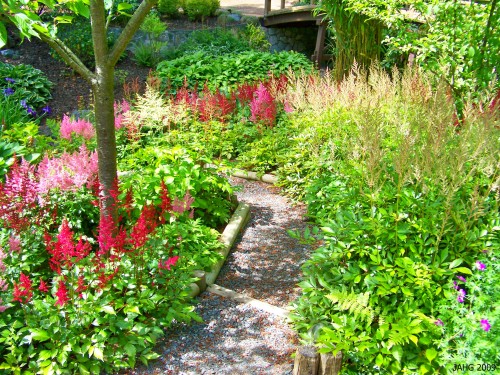One of the hardest thing for new students who are taking Horticultural courses is being exposed to a form of Latin for the first time; Botanical Latin that is. We were given a test to see how well we could spell the botanical Latin names of the first plant we were learning and of course we all failed (it was planed this way!). We learned from this experience how difficult and how it would be first on the list of things we would have to study every night. Many people created ways to remember the plants spelling and pronunciation. One plant I remember people doing this for was the plant Buddleja davidii or (Butterfly Bush), they did it like this: My ‘Bud’ ‘Lea’ and ‘I’ went out with ‘David’, or something like that.

Buddleja davidii fully in bloom, note the tiny orange centers of each flower.
There is some confusion with the name Buddleja and it’s spelling. When I was in school we learned it as ‘Buddliea’ which is logical in botanical spelling terms. The spelling ‘Buddleja’ was actually said to be spelling mistake made by ‘Linnaeus ‘ with the name ‘Buddle’ . In botanical naming protocol, the original name should take precedence over newer spellings, The letters ‘J’ and ‘I’ are seen as being interchangeable and can be considered orthographical variants in this case.

A recently planted Buddleja Davidii 'Black Knight' planted at Government House.
There are about 150 species of Buddlejas which only a few are grown outside of botanical gardens. Buddleja was named after Rev Adam Buddle (1660-1715), an English botanist and Pere Armand David(davidii). This Buddleja was named and described by Franchet in 1887. Buddleja davidii is by far the most commonly grown. It was discovered in central China(Sichuan and Hubei provinces) and was introduced into cultivation in 1890. It was an immediate hit and was awarded an Award of Merit in 1898. That form of the plant had a mid-magenta purple flower color, since that time many color forms have been found. There are at least 3 variegated form which are highly sought after.

Buddleja davidii 'Harlequin', a sought after sport of 'Royal Red'.
Buddleja davidii have been a very successful introduction into cultivation and where they are happy they can become something of a pest by self-seeding and forming thickets. This need not be the case as butterfly Bushes are easy to control by deadheading after they bloom and can be cut right down to 2ft if need be. Butterfly Bushes are adaptable to many areas including difficult coastal zones. Their late season bloom is useful to give color in this hot time of the year and they have an added bonus of being pleasantly fragrant. They can be used in deep shrub or perennial borders, massed planted, cottage style gardens, as specimens and as butterfly attractants.

A 'Buddleja davidii' pruned into a tree, very attractive and fragrant.
It is easy to grow a Butterfly Bush, you need full sun for the best bloom, rich well drained soil and water during their prolonged growing season. they are considered to be fairly drought tolerant. They grow into quite large opens shrubs 3m(12ft) x 4m(15ft) wide and can be pruned into a more tree form if wanted. The form B. davidii var. nahonensis is smaller form(1.5m or 4ft) which has become popular in small gardens. They grow best in a temperature down to -15c(-1f.) In colder areas they will be cut down to the ground, but, because they are so fast growing and bloom on new wood you can expect a crop of flowers.

Buddleja davidii 'White Cloud' in a perennial border.
More on Buddleja davidii:
About buddlejas in general; http://en.wikipedia.org/wiki/Buddleja
Adam Buddle: http://en.wikipedia.org/wiki/Adam_Buddle
Growing Buddlejas: http://www.gardenseeker.com/plants_a_z/buddleja_davidii.htm
Until We Meet Again Here….





















 Stumble It!
Stumble It!






